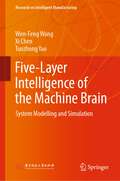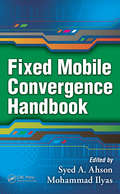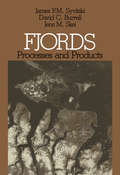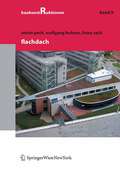- Table View
- List View
Five Decades of Tackling Models for Stiff Fluid Dynamics Problems: A Scientific Autobiography
by Radyadour Kh. ZeytounianRationality - as opposed to 'ad-hoc' - and asymptotics - to emphasize the fact that perturbative methods are at the core of the theory - are the two main concepts associated with the Rational Asymptotic Modeling (RAM) approach in fluid dynamics when the goal is to specifically provide useful models accessible to numerical simulation via high-speed computing. This approach has contributed to a fresh understanding of Newtonian fluid flow problems and has opened up new avenues for tackling real fluid flow phenomena, which are known to lead to very difficult mathematical and numerical problems irrespective of turbulence. With the present scientific autobiography the author guides the reader through his somewhat non-traditional career; first discovering fluid mechanics, and then devoting more than fifty years to intense work in the field. Using both personal and general historical contexts, this account will be of benefit to anyone interested in the early and contemporary developments of an important branch of theoretical and computational fluid mechanics.
Five-Layer Intelligence of the Machine Brain: System Modelling and Simulation (Research on Intelligent Manufacturing)
by Wen-Feng Wang Xi Chen Tuozhong YaoThis book intends to report the new results of the efforts on the study of Layered Intelligence of the Machine Brain (LIMB). The book collects novel research ideas in LIMB and summarizes the current machine intelligence level as “five layer intelligence”- environments sensing, active learning, cognitive computing, intelligent decision making and automatized execution. The book is likely to be of interest to university researchers, R&D engineers and graduate students in computer science and electronics who wish to learn the core principles, methods, algorithms, and applications of LIMB.
The Five Year Lie: A totally unputdownable domestic thriller with a pulse-pounding romance
by Sarina BowenWhat if you got a text from the love of your life... five years after he died?On an ordinary Monday morning, Ariel's phone buzzes with a text: Something's happened. I need to see you. Meet me under the candelabra tree ASAP.Her heat skips a beat. The message is from Drew, the only guy she's ever loved. The father of her child. The man who up and left five years ago without a word. The man who died shortly after in a motorcycle accident.The text upends everything she knew about the day he vanished. Only two things are clear: everything she was told back then is a lie, and someone is still deceiving her today.The truth is out there, and Ariel will do anything to find it. But she has no idea that if it finds her first, she and her four-year-old son will be in terrible danger.For fans of The Housemaid, It Ends With Us and The Last Thing He Told Me, and with a heart-stopping romance that only Sarina Bowen can execute, The Five Year Lie is a page-turning, spine-tingling thriller that will have you guessing until the very end.'YES, YES, YES!!! ... I absolutely loved this book. A little bit of romance, a lot of suspense, and all the best aspects of a domestic thriller. I fell in love... Will keep you turning the pages as fast as you can' *****'The best book I've read in a long time. Had me hooked from the first page and I had to hurry and figure out what happened!' *****'I loved it! This had me hooked right away ... Fast paced and twisty ... Will keep you on the edge of your seat' *****'I devoured it in two days' *****
Fixed Broadband Wireless System Design
by Harry R. AndersonFixed broadband networks can provide far higher data rates and capacity than the currently envisioned 3G and 4G mobile cellular systems. Achieving higher data rates is due to the unique technical properties of fixed systems, in particular, the use of high gain and adaptive antennas, wide frequency bands, dynamic data rate and channel resource allocation, and advanced multiple access techniques. Fixed Broadband Wireless System Design is a comprehensive presentation of the engineering principles, advanced engineering techniques, and practical design methods for planning and deploying fixed wireless systems, including: Point-to-point LOS and NLOS network design Point-to-point microwave link design including active and passive repeaters Consecutive point and mesh network planning Advanced empirical and physical propagation modeling including ray-tracing Detailed microwave fading models for multipath and rain NLOS (indoor and outdoor) propagation and fading models Propagation environment models including terrain, morphology, buildings, and atmospheric effects Novel mixed application packet traffic modeling for dimensioning network capacity Narrow beam, wide beam, and adaptive (smart) antennas MIMO systems and space-time coding Channel planning including fixed and dynamic channel assignment and dynamic packet assignment IEEE 802.11b and 802.11a (WLAN) system design Free space optic (FSO) link design At present, there are no titles available that provide such a concise presentation of the wide variety of systems, frequency bands, multiple access techniques, and other factors that distinguish fixed wireless systems from mobile wireless systems. Fixed Broadband Wireless System Design is essential reading for design, system and RF engineers involved in the design and deployment of fixed broadband wireless systems, fixed wireless equipment vendors, and academics and postgraduate students in the field.
Fixed Interval Smoothing for State Space Models (The Springer International Series in Engineering and Computer Science #609)
by Howard L. WeinertFixed-interval smoothing is a method of extracting useful information from inaccurate data. It has been applied to problems in engineering, the physical sciences, and the social sciences, in areas such as control, communications, signal processing, acoustics, geophysics, oceanography, statistics, econometrics, and structural analysis. This monograph addresses problems for which a linear stochastic state space model is available, in which case the objective is to compute the linear least-squares estimate of the state vector in a fixed interval, using observations previously collected in that interval. The author uses a geometric approach based on the method of complementary models. Using the simplest possible notation, he presents straightforward derivations of the four types of fixed-interval smoothing algorithms, and compares the algorithms in terms of efficiency and applicability. Results show that the best algorithm has received the least attention in the literature. Fixed Interval Smoothing for State Space Models: includes new material on interpolation, fast square root implementations, and boundary value models; is the first book devoted to smoothing; contains an annotated bibliography of smoothing literature; uses simple notation and clear derivations; compares algorithms from a computational perspective; identifies a best algorithm. Fixed Interval Smoothing for State Space Models will be the primary source for those wanting to understand and apply fixed-interval smoothing: academics, researchers, and graduate students in control, communications, signal processing, statistics and econometrics.
Fixed Mobile Convergence Handbook
by Syed A. Ahson Mohammad IlyasRequirements for next generation networks (NGNs) are fueling an architectural evolution. Service providers are obliged to give users access to content anytime, anyhow, anywhere, on any device. This requires a converged infrastructure in which users across multiple domains can be served through a single unified domain and all network services and business units can be consolidated on a single IP infrastructure. The Fixed Mobile Convergence Handbook is a comprehensive guide to the design, implementation, and management of converged cellular/WiFi wireless networks. This book discusses how FMC is transforming technologies as multimedia ceases to be passively consumed and unidirectional—and becomes increasingly mobile, personalized and interactive. This book also describes ways to ensure that networks remain cost-effective, scalable, reliable, and secure in the face of constant technological evolution. This material encapsulates the state of FMC, covering everything from basic concepts to research-grade material and future directions. Addressing a broad range of topics, the handbook consists of 16 chapters authored by 44 experts from around the world. Subjects include: Femtocell network technology and applications Deployment modes and interference avoidance Architecture for power efficiency Conversational quality and network planning Design of SIP-based mobility management protocols Highly respected in their field, the authors anticipate the key issues and problems that FMC presents—from application inception and deployment to system interconnection and Quality of Service (QoS). Ideal for professional mobile technology designers and/or planners, researchers (faculty members and graduate students), this book provides specific salient features and information that will guide innovation in the 21st century and beyond. Syed Ahson is a senior software design engineer with Microsoft. Previously, he was a senior staff software engineer with Motorola, where he was a leading contributor in the creation of several iDEN, CDMA, and GSM cellular phones. Dr. Mohammad Ilyas is associate dean for research and industry relations at the College of Engineering and Computer Science at Florida Atlantic University, Boca Raton. A consultant to several national and international organizations, Dr. Ilyas is a member of both the IEEE and ASEE.
Fixed Mobile Convergence Handbook
by Syed A. Ahson and Mohammad IlyasRequirements for next generation networks (NGNs) are fueling an architectural evolution. Service providers are obliged to give users access to content anytime, anyhow, anywhere, on any device. This requires a converged infrastructure in which users across multiple domains can be served through a single unified domain and all network services and business units can be consolidated on a single IP infrastructure. The Fixed Mobile Convergence Handbook is a comprehensive guide to the design, implementation, and management of converged cellular/WiFi wireless networks. This book discusses how FMC is transforming technologies as multimedia ceases to be passively consumed and unidirectional—and becomes increasingly mobile, personalized and interactive. This book also describes ways to ensure that networks remain cost-effective, scalable, reliable, and secure in the face of constant technological evolution. This material encapsulates the state of FMC, covering everything from basic concepts to research-grade material and future directions. Addressing a broad range of topics, the handbook consists of 16 chapters authored by 44 experts from around the world. Subjects include: Femtocell network technology and applications Deployment modes and interference avoidance Architecture for power efficiency Conversational quality and network planning Design of SIP-based mobility management protocols Highly respected in their field, the authors anticipate the key issues and problems that FMC presents—from application inception and deployment to system interconnection and Quality of Service (QoS). Ideal for professional mobile technology designers and/or planners, researchers (faculty members and graduate students), this book provides specific salient features and information that will guide innovation in the 21st century and beyond. Syed Ahson is a senior software design engineer with Microsoft. Previously, he was a senior staff software engineer with Motorola, where he was a leading contributor in the creation of several iDEN, CDMA, and GSM cellular phones. Dr. Mohammad Ilyas is associate dean for research and industry relations at the College of Engineering and Computer Science at Florida Atlantic University, Boca Raton. A consultant to several national and international organizations, Dr. Ilyas is a member of both the IEEE and ASEE.
Fixed Offshore Platforms:Structural Design for Fire Resistance
by Mavis Sika OkyereThis book examines the fire-resistant design of fixed offshore platforms. It describes the required loading, load combinations, strength and stability checks for structural elements. It also explains the design of tubular joints, fatigue analysis, dynamic analysis, and impact analysis, Fire resistance, fire, explosion and blast effect analysis, fire protection materials, and safety.
Fixed Offshore Platforms:Structural Design for Fire Resistance
by Mavis Sika OkyereThis book examines the fire-resistant design of fixed offshore platforms. It describes the required loading, load combinations, strength and stability checks for structural elements. It also explains the design of tubular joints, fatigue analysis, dynamic analysis, and impact analysis, Fire resistance, fire, explosion and blast effect analysis, fire protection materials, and safety.
Fixed-Point Signal Processing (Synthesis Lectures on Signal Processing)
by Wayne Padgett David AndersonThis book is intended to fill the gap between the ""ideal precision"" digital signal processing (DSP) that is widely taught, and the limited precision implementation skills that are commonly required in fixed-point processors and field programmable gate arrays (FPGAs). These skills are often neglected at the university level, particularly for undergraduates. We have attempted to create a resource both for a DSP elective course and for the practicing engineer with a need to understand fixed-point implementation. Although we assume a background in DSP, Chapter 2 contains a review of basic theory and Chapter 3 reviews random processes to support the noise model of quantization error. Chapter 4 details the binary arithmetic that underlies fixed-point processors and then introduces fractional format for binary numbers. Chapter 5 covers the noise model for quantization error and the effects of coefficient quantization in filters. Because of the numerical sensitivity of IIR filters, they are used extensively as an example system in both Chapters 5 and 6. Fortunately, the principles of dealing with limited precision can be applied to a wide variety of numerically sensitive systems, not just IIR filters. Chapter 6 discusses the problems of product roundoff error and various methods of scaling to avoid overflow. Chapter 7 discusses limit cycle effects and a few common methods for minimizing them. There are a number of simple exercises integrated into the text to allow you to test your understanding. Answers to the exercises are included in the footnotes. A number of MATLAB examples are provided in the text. They generally assume access to the Fixed-Point Toolbox. If you lack access to this software, consider either purchasing or requesting an evaluation license from The Mathworks. The code listed in the text and other helpful MATLAB code is also available at http://www.morganclaypool.com/page/padgett and http://www.rose-hulman.edu/padgett/fpsp. You will also find MATLAB exercises designed to demonstrate each of the four types of error discussed in Chapters 5 and 6. Simulink examples are also provided on the web site. Table of Contents: Getting Started / DSP Concepts / Random Processes and Noise / Fixed Point Numbers / Quantization Effects: Data and Coefficients / Quantization Effects - Round-Off Noise and Overflow / Limit Cycles
Fixed-Time Cooperative Control of Multi-Agent Systems
by Qing-Long Han Zongyu Zuo Boda NingThis monograph presents new theories and methods for fixed-time cooperative control of multi-agent systems. Fundamental concepts of fixed-time stability and stabilization are introduced with insightful understanding. This book presents solutions for several problems of fixed-time cooperative control using systematic design methods. The book compares fixed-time cooperative control with asymptotic cooperative control, demonstrating how the former can achieve better closed-loop performance and disturbance rejection properties. It also discusses the differences from finite-time control, and shows how fixed-time cooperative control can produce the faster rate of convergence and provide an explicit estimate of the settling time independent of initial conditions. This monograph presents multiple applications of fixed-time control schemes, including to distributed optimization of multi-agent systems, making it useful to students, researchers and engineers alike.
The Fixer
by Joseph FinderWhat secrets are his family keeping? A month ago, Rick Hoffman was a popular journalist. Now, having being fired by his magazine, he is penniless and alone. At least he still has keys to his father's house, which has been empty since he moved to a nursing home after a stroke. There, hidden in the walls of his father's attic, Rick finds something that could change his life: bundles of cash worth millions. He knows he shouldn't spend it without asking where it came from. But his bed-bound father can no longer speak. What Rick doesn't realise is that, if he could, he'd tell his son just how much danger he is in... Recent reviews for Joseph Finder: 'Stunning... I can't remember when I last read a book so gripping and so satisfying' PETER JAMES. 'Smart, swift and well-informed' SCOTT TUROW. 'Terrific' IAN RANKIN. 'A writer at the top of his game' MARK BILLINGHAM. 'Fantastic... Kept me absolutely on the edge of my seat' MARTINA COLE. 'Timely, twisty and impossible to put down' KARIN SLAUGHTER. 'A masterclass in ratcheting up the tension... A classy, sophisticated thriller' J.P. DELANEY.
Fixer the Robot
by John KellyEvery morning, FIXER robot,trundles up the hillTo help the other robots as theydig and push and drill.A charming text that combines a truly heart-wrenching story with mechanical details, sure to enchant every young engineer.
Fjords: Processes and Products
by James P.M. Syvitski David C. Burrell Jens M. SkeiFjords are both an interface and a buffer between glaciated continents and the oceans. They exhibit a very wide range in environmental conditions, both in dynamics and geography. Some are truly wonders of the world with their dizzying mountain slopes rising sharply from the ocean edge. Others represent some of the harshest conditions on earth, with hurricane winds, extremes in temperature, and catastrophic earth and ice movements. Fjords are unique estuaries and represent a large portion of the earth's coastal zone. Yet they are not very well known, given the increasing population and food pressures, and their present industrial and strategic importance. Temperate zone estuaries have had many more years of intense study, with multiyear data available. Most fjords have not been impacted by man but, if history repeats itself, that condition will not last long. Fjords present some unique environmental problems, such as their usually slow flushing time, a feature common to many silled environments. Thus there is presently a need for management guidelines, which can only be based on a thorough knowledge of the way fjords work. Fjords are, in many respects, perfect natural oceanographic and geologic lab oratories. Source inputs are easily identified and their resulting gradients are well developed. Throughout this book, we emphasize the potential of modeling pro cesses in fjords, with comparisons to other estuary, lake, shelf and slope, and open ocean environments.
Flachdach (Baukonstruktionen #9)
by Anton Pech Wolfgang Hubner Franz ZachDas Flachdach als großflächiger Bauteil ist den höchsten Belastungen amGesamtbauwerk ausgesetzt. Speziell im Hinblick auf die künftigen Auswirkungen des Klimawandels muss die Planung und Ausführung von Flachdächern schon heute abgestimmt werden. Der vorliegende Band gibt daher – ausgehend von der Behandlung der Grundkonstruktionen – eine ausführliche und fundierte Darstellung dieses Fachgebietes, wobei den immer aktueller werdenden begrünten Dächern ein eigener Abschnitt gewidmet ist. Besonderes Augenmerk ist bei Flachdächern auchder Ausbildung von Durchdringungen und Anschlüssen zu widmen.
Flächenheiz- und Flächenkühlsysteme: Grundlagen – Wärmephysiologie – Auslegung – Systemintegration
by Joachim SeifertDieses Buch beschreibt die grundlegenden Konstruktionen von Flächenheiz- und Flächenkühlsystemen aus theoretischer Sicht. Die Wirkung der Systeme wird in Hinblick auf die thermische Behaglichkeit beschrieben. Zusätzlich erfolgt eine detaillierte Betrachtung der Systemintegration.
Flächenorientierte Steuerdatenaufbereitung für das fünfachsige Fräsen (ISW Forschung und Praxis #88)
by Wei-Tai LeiFlächenorientierte Termin- und Kapazitätsplanung bei innerbetrieblicher Baustellenfertigung (IPA-IAO - Forschung und Praxis #152)
by Rolf SchlauchFlächenrecycling: Inwertsetzung, Bauwürdigkeit, Baureifmachung
by Reiner Kompa Michael Von Pidoll Bernd SchreiberFlächenrecycling durch kontrollierten Rückbau: Ressourcenschonender Abbruch von Gebäuden und Industrieanlagen
by Eva Koch Ulrich SchneiderAktueller Überblick über alle Aspekte des kontrollierten Rückbaus - praxisorientiert und mit zahlreichen Fallbeispielen veranschaulicht.
Flächenschluß: System der Formen lückenlos aneinanderschließender Flachteile (Wissenschaftliche Normung #6)
by H. Heesch O. KienzleFlächentragwerke: Einführung in die Elastostatik der Scheiben, Platten, Schalen und Faltwerke
by Karl GirkmannFlächentragwerke: Einführung in die Elastostatik der Scheiben, Platten, Schalen und Faltwerke
by Karl GirkmannFlächentragwerke: Einführung in die Elastostatik der Scheiben, Platten, Schalen und Faltwerke
by Karl GirkmannFlächentragwerke: Einführung in die Elastostatik der Scheiben, Platten, Schalen und Faltwerke
by Karl GirkmannDas vorliegende Buch behandelt die Berechnung von Flächentrag werken. Es sind dies dünnwandige, nach Flächen geformte Traggebilde. Ihre Mittelfläche - jene Fläche, die an jeder Stelle die Dicke halbier- kann eben sein, sie kann einfach oder doppelt gekrümmt sein, und sie kann aus ebenen und gekrümmten Teilflächen zusammengesetzt sein. Ein ebener Flächenträger, der nur durch Kräfte belastet ist, die in seiner Ebene wirken, wird Scheibe genannt. Greifen auch (oder ausschließlich) quer zur Mittelebene gerichtete Kräfte an, dann wird der ebene Flächen träger als Platte bezeichnet. Ist die Mittelfläche eines Flächentragwerkes gekrümmt oder aus gekrümmten und ebenen Teilflächen zusammengesetzt, dann sprechen wir von einer Schale bzw. einem Schalentragwerk. Wird die Mittelfläche nur von ebenen Teilflächen gebildet, dann wird das Trag werk Faltwerk genannt. Alle angeführten Bauformen, einschließlich der Scheiben und Platten, werden unter dem Titel Flächentragwerke zu sammengefaßt. In der Regel müssen diese Tragwerke bereits nach der Theorie der mehrdimensionalen Systeme berechnet werden. Beim Entwurf von Tragwerken des Stahl- und des Stahlbetonbaues ist es nun häufig notwendig, einzelne Bauglieder als Flächentragwerke aufzufassen, um die Größe und den Verlauf der inneren Kräfte hin reichend genau ermitteln zu können. Im Stahlbau sind es verschiedene wichtige Krafteinleitungs- und Kraftverteilungsprobleme, Stabilitäts untersuchungen für dünne Bleche, Probleme des Zusammenwirkens von stab- und plattenförmigen BaugIiedern, Behälteraufgaben usw. , die in dieser Weise behandelt werden müssen.






















